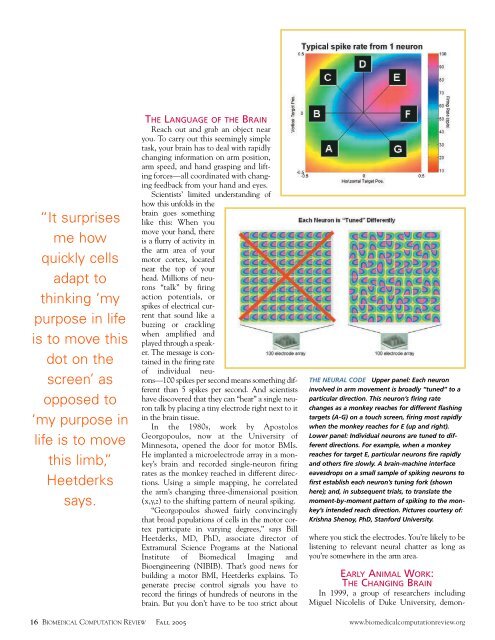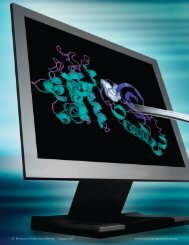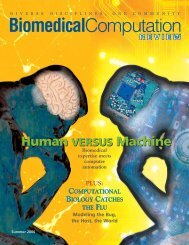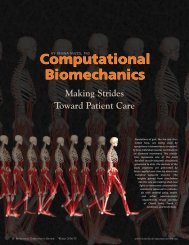here - Biomedical Computation Review
here - Biomedical Computation Review
here - Biomedical Computation Review
Create successful ePaper yourself
Turn your PDF publications into a flip-book with our unique Google optimized e-Paper software.
“It surprisesme howquickly cellsadapt tothinking ‘mypurpose in lifeis to move thisdot on thescreen’ asopposed to‘my purpose inlife is to movethis limb,”Heetderkssays.THE LANGUAGE OF THE BRAINReach out and grab an object nearyou. To carry out this seemingly simpletask, your brain has to deal with rapidlychanging information on arm position,arm speed, and hand grasping and liftingforces—all coordinated with changingfeedback from your hand and eyes.Scientists’ limited understanding ofhow this unfolds in thebrain goes somethinglike this: When youmove your hand, t<strong>here</strong>is a flurry of activity inthe arm area of yourmotor cortex, locatednear the top of yourhead. Millions of neurons“talk” by firingaction potentials, orspikes of electrical currentthat sound like abuzzing or cracklingwhen amplified andplayed through a speaker.The message is containedin the firing rateof individual neurons—100spikes per second means something differentthan 5 spikes per second. And scientistshave discovered that they can “hear” a single neurontalk by placing a tiny electrode right next to itin the brain tissue.In the 1980s, work by ApostolosGeorgopoulos, now at the University ofMinnesota, opened the door for motor BMIs.He implanted a microelectrode array in a monkey’sbrain and recorded single-neuron firingrates as the monkey reached in different directions.Using a simple mapping, he correlatedthe arm’s changing three-dimensional position(x,y,z) to the shifting pattern of neural spiking.“Georgopoulos showed fairly convincinglythat broad populations of cells in the motor cortexparticipate in varying degrees,” says BillHeetderks, MD, PhD, associate director ofExtramural Science Programs at the NationalInstitute of <strong>Biomedical</strong> Imaging andBioengineering (NIBIB). That’s good news forbuilding a motor BMI, Heetderks explains. Togenerate precise control signals you have torecord the firings of hundreds of neurons in thebrain. But you don’t have to be too strict aboutTHE NEURAL CODE Upper panel: Each neuroninvolved in arm movement is broadly “tuned” to aparticular direction. This neuron’s firing ratechanges as a monkey reaches for different flashingtargets (A-G) on a touch screen, firing most rapidlywhen the monkey reaches for E (up and right).Lower panel: Individual neurons are tuned to differentdirections. For example, when a monkeyreaches for target E, particular neurons fire rapidlyand others fire slowly. A brain-machine interfaceeavesdrops on a small sample of spiking neurons tofirst establish each neuron’s tuning fork (shown<strong>here</strong>); and, in subsequent trials, to translate themoment-by-moment pattern of spiking to the monkey’sintended reach direction. Pictures courtesy of:Krishna Shenoy, PhD, Stanford University.w<strong>here</strong> you stick the electrodes. You’re likely to belistening to relevant neural chatter as long asyou’re somew<strong>here</strong> in the arm area.EARLY ANIMAL WORK:THE CHANGING BRAINIn 1999, a group of researchers includingMiguel Nicolelis of Duke University, demon-16 BIOMEDICAL COMPUTATION REVIEW Fall 2005www.biomedicalcomputationreview.org












